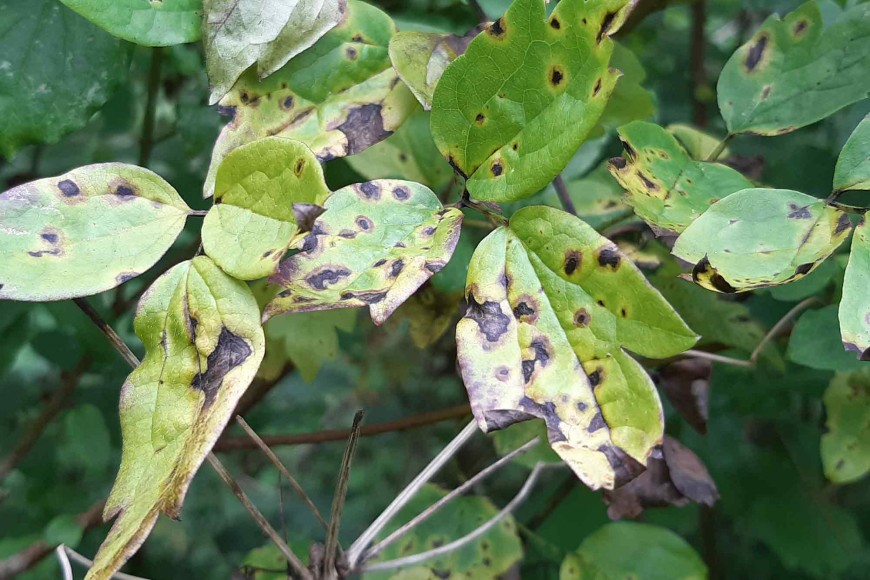A Fresh Search for Old Man’s Beard Pathogens

Old man's beard pathogen symptoms
Although three invertebrate biocontrol agents (a mite, Aceria vitalba, a sawfly, Monophadnus spinolae, and a leaf miner Phytomyza vitalbae) are now established on old man’s beard the severity of the problem in NZ warrants further investigation into a damaging plant pathogen that will hopefully complement the damage of the three agents now present.
Collaborators at the Centre for Agriculture and BioScience International (CABI) in the United Kingdom (UK) have been contracted to conduct exploratory work in the native range in the search for plant pathogens as potential biocontrol agents for old man’s beard. The first step included a desktop study to catalogue information about plant pathogens previously recorded from old man’s beard. Dr Sarah Thomas (plant pathologist, CABI) conducted a literature review and database search, as well as a visit to Kew Herbarium, to catalogue the pathogens recorded from old man’s beard. A total of 252 old man’s beard specimens from 25 countries are contained in the collection at Kew, some dating back to the 1800s. Specimens from the United Kingdom, Russia, Germany, Switzerland, Austria, Hungary, Romania, Holland, Belgium, France, Italy, Sicily, Portugal, Spain, Yugoslavia, Bulgaria, Greece, Crete, Turkey (Europe), the Caucasus, Persia, Syria, Lebanon, and Cyprus were examined. Many specimens displayed symptoms similar to those commonly observed during the original field surveys.
A climate modelling study to identify the most climatically suitable regions of Europe to undertake field surveys was also completed by CABI. The software CLIMEX was used to match climatically similar regions in NZ and the native range of old man's beard in France, Ireland, Spain, Portugal and the UK.
Old man’s beard has an extensive native distribution, so genetic matching of plant populations in NZ and the native range also helped to narrow the search area. An earlier study suggested that old man’s beard plants in NZ may have originated from Italy, the UK, Germany, and France. CABI will collect plant samples during their field surveys for further analysis to pinpoint populations in the collection areas that both yielded promising pathogens and are closely related to NZ old man’s beard.
The first field surveys for old man’s beard pathogens began in the UK in April 2021, but it turned out to be a very cold spring with several frosts, which delayed budding of old man’s beard plants until the end of May. Surveys were started again in early June, with a number of field trips carried out in England and Wales. Travel between European countries was still difficult at this time due to pandemic restrictions, but Dr Marion Seier (plant pathologist, CABI) managed a short visit to Germany in August that same year. Symptoms observed in the field in the UK and Germany consisted of dark brown to black lesions, infecting both the leaves and stems of old man’s beard plants. However, there was variation in the size and shape of these lesions and the amount of associated yellowing.
From the limited number of surveys so far it appears that the most abundant fungal pathogen present on old man’s beard is what we have known as ‘Phoma clematidina’. However, molecular testing identified a subset of the isolates as Longididymella vitalbae. The taxonomy of the Longididymella genus is extremely complex, but, briefly, this pathogen is the one that was originally described from old man’s beard plants from Europe (Switzerland, France, Germany, and the Netherlands), while the plant pathogen ‘Phoma clematidina isolate’ released in 1996 as a biocontrol agent in NZ is now classified as a different species in the Longididymella genus (Longididymella clematidis).
Our UK collaborators are surveying in Spain, Italy, and Ireland from July onwards to expand the search for plant pathogens, and to collect leaf samples for the molecular work. Recently, seeds were sent to CABI for propagating old man’s beard plants from NZ. They’ll also grow plants from Europe to develop an inoculation methodology, enabling them to determine whether the key promising pathogens cause disease symptoms on NZ plants.
